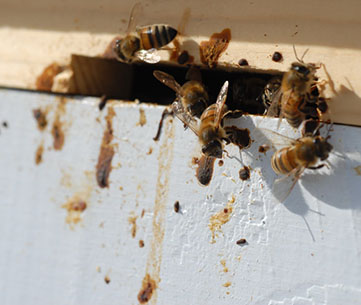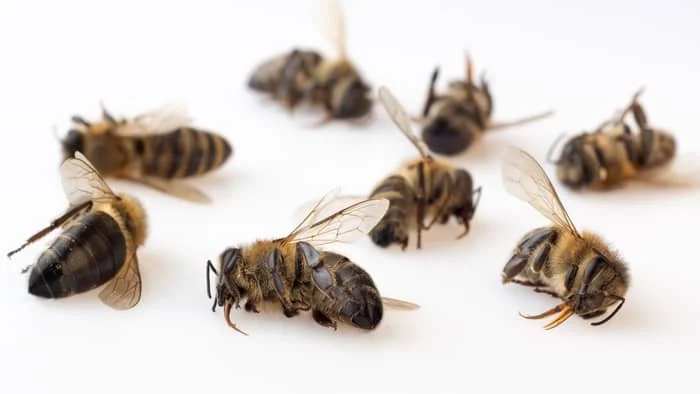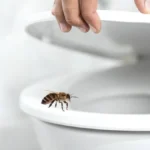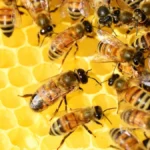When beekeepers talk about Nosema in bees they are really talking about infection caused by the obligate microsporidian parasites Nosema apis and Nosema ceranae. Now that is a terribly complex-sounding introduction to this article – let’s spend the rest of this making it easier to understand! Nosema treatment/prevention in bees is an important part of what we do to look after our bees.
What is Bee Hive Nosema?
Nosema is a small parasitic fungus. If you read older books they will tell you that they are Protozoa. Recent advances in science have apparently cleared up that confusion. To be more precise, Nosema is a microsporidian parasite. These are a vast family of parasites estimated to contain over a million species. They primarily infect insects, as well as other animals. They are pretty specific, so you will normally find a specific microsporidian fungus that will infect a single species or closely related species. Herein lies the disaster with bees.
Nosema apis was restricted to the Western Honey bee – Apis mellifera – and infected bees in Africa, Europe, and Russia. This is the natural range of the Western Honey bee. Nosema ceranae infected the Eastern Honeybee – Apis cerana. This bee is found in the East – India, heading eastwards to China, Japan, and all the other Islands in that area bar Australia and New Zealand.
Humans being the technologically advanced common sense poor species that we are have moved bees all over the world. Now Nosema apis and Nosema ceranae infect the Western Honeybee. When I started keeping bees, Nosema apis was all we really heard about. Nosema ceranae has eclipsed Nosema apis in the past three decades and is now the dominant cause of Nosema in bees.

How Does Nosema Infect Honey Bees?
For simplicity, if I write Nosema, I am referring to both species. If I need to specify a specific species later for clarity, I will do so. Nosema is a spore-forming fungus. Bees are infected via the oral route – when they ingest spores from honey, nectar, pollen, or bee poop (those yellow smears on your window). The spores germinate inside the midgut of the bee. A tube extends out of the spore and injects infectious material into the host cell.
Once a cell is infected, neighboring cells become infected. When fully infected cells begin to die, they release environmental spores (tougher spores) that are released into the midgut of the bee. This results in the bee getting a terrible case of bee Diarrhea. This aids in getting the spores outside the bee where they can then infect other bees.
What Happens To Bees Infected With Nosema
This depends on the race of bees and the time of year and overall health. I have seen some bees that just recover and get over it (African Bees). I have seen bees die of it (European bees) and I have seen some races of European bees survive Nosema with barely any effect at all.
Generally for bees that are susceptible to Nosema, the worse of the two, Nosema ceranae, can actually destroy a colony. It will depend on your area, and it is important to find out from local beekeepers what the level of concern should be for Nosema in your area.
Generally, Nosema is identified using a microscope – and given the similarity between N.apis and N.ceranae, it is really difficult to distinguish them.

Learn more about: What Are K Wing Bees?
Nosema Treatment For Honey Bees
The tried and tested treatment for Nosema is generally Fumagilin-B. This is an antibiotic produced by the fungus Aspergillus fumigatus. There is however increasing evidence that this is a pretty nasty chemical – it is teratogenic. This means it causes permanent changes to DNA – this is really bad. It also causes aberrations in how bees function, and it is carcinogenic. This is why it has been banned in the EU.
If you are in the US, where Fumagilin is still legal for treatment, the normal method of treatment is to provide bees with the antibiotic in sugar solution in spring and autumn. The idea is to reduce the spore count and the fungal load in your bees so that they overwinter and build up well in spring.
Ventilation and Nosema Control in Bee Hives
My general experience with Nosema is that it gets a lot worse in a badly ventilated hive. Ensure that your hives are well ventilated. In winter, a candy board can help reduce moisture build-up.
Ensure that your bees are well fed and that they are in an area where there is abundant diverse pollen. Much like a human living on a diet of hamburgers, a beehive living on a diet of one or two types of pollen is weak. A diverse diet makes any animal healthier.
I have seen bees develop nosema problems when working on Canola – this is an incredible honey flow, but it is also a single pollen source. The bees always start off well, and then after a few weeks, you start to see they get malnourished. At the end of the Canola flow, you will see the characteristic splats on the front of the hive of Nosema bee poop. Generally in my area, the bees recover on their own as soon as you move them to better forage.
A Funny Beehive Nosema Story
My beekeeping mentor was a well-known Professor who wrote a number of great books on the bees of the world. He wore glasses and was a bit of a rascal-type character. He smoked constantly, swore more than he used normal words, and had a generally scary temperament.
We were opening some hives we had bought in for an experiment. These had been on Canola just before being moved. The hives were in bad shape. The bees had distended abdomens and the insides of the hives were slimy with bee poop. This is a very bad state for a hive to be in.
Prof was opening hives – as he characteristically did with no bee suit and using only a cigarette as a smoker. A big sad bee flew slowly towards him and in the morning sunlight, I remember seeing the orange streak of bee poop ark out of the bee. It hit Prof’s glasses straight on, and he was covered in this stinky bee poop.
I heard swear words I have never heard again. After the air cleared a bit, he said “smell my glasses – so you know what Nosema smells like”. That was a lesson well taught. I will never forget the smell. It is a bit like baby vomit, kombucha, and the smell of dirty feet all mixed into one undelightful stench.
I hope this article has helped you understand Nosema, how to treat it, and how to prevent it. If you enjoyed this, please share. And hold a kind thought for my cantankerous mentor and his nosema poop splattered glasses. A good man under all of that anger.
Read more about: Chalkbrood Treatment
Bee Hive Nosema Treatment FAQs
What is Nosema in bees?
Nosema is a parasitic fungus that infects honeybees, causing digestive issues and weakening colonies. Two main species, Nosema apis and Nosema ceranae, can infect bees.
How do bees get infected with Nosema?
Bees become infected by ingesting Nosema spores through contaminated food like nectar, pollen, or even bee feces. The spores infect the bee’s midgut, leading to symptoms like diarrhea.
What are the symptoms of Nosema in bees?
Symptoms include bees having distended abdomens, reduced honey production, diarrhea in and around the hive, and a weakened or declining colony.
How can Nosema affect a bee colony?
Nosema can severely weaken or even destroy a colony by impairing the bees’ digestive system, causing malnutrition, disorientation, and in severe cases, death.
What is the best treatment for Nosema in bees?
Fumagilin-B is the most common treatment for Nosema in bees, although it’s banned in some regions due to potential health risks for bees and humans. Preventive measures like good hive ventilation and balanced diets are also crucial.
Is Fumagilin-B safe for bees?
Fumagilin-B has been effective, but concerns have risen due to its teratogenic and carcinogenic properties, leading to its ban in the European Union. Alternatives focus on hive management and natural treatments.
How does hive ventilation help control Nosema?
Poorly ventilated hives create moist environments, which worsen Nosema infections. Ensuring proper air circulation in the hive can prevent the disease from spreading.
Can a diverse pollen diet help prevent Nosema?
Yes, a diverse diet strengthens bees’ immune systems, helping them resist Nosema infections. Bees that rely on a single pollen source are more susceptible to malnutrition and disease.
Can bees recover from Nosema without treatment?
In some cases, bees, especially certain resilient species like African bees, can recover from Nosema on their own if moved to a healthier environment with better forage.
How can I prevent Nosema in my bee colony?
Ensure good hive ventilation, provide a diverse diet of pollen sources, and keep the hive clean to prevent Nosema spores from spreading. Regular inspections also help catch early signs of infection.

Dr. Garth A. Cambray is a Canadian/South African entrepreneur and beekeeper with 28 years of experience in apiculture and specializes in adding value to honey. His Ph.D. research developed a new advanced continuous fermentation method for making mead that has resulted in a number of companies globally being able to access markets for mead. His company, Makana Meadery, exports honey mead to the USA where it is available to discerning connoisseurs. He has also developed technologies to commercially manufacture organic honey vinegar in Zambia for export globally. He holds a few patents globally in the ethanol industry and believes in technology and knowledge transfer for human development and environmental sustainability. One of his proudest achievements is the fact that the wind farm he started at one of his old apiary sites has essentially made his hometown carbon neutral.






